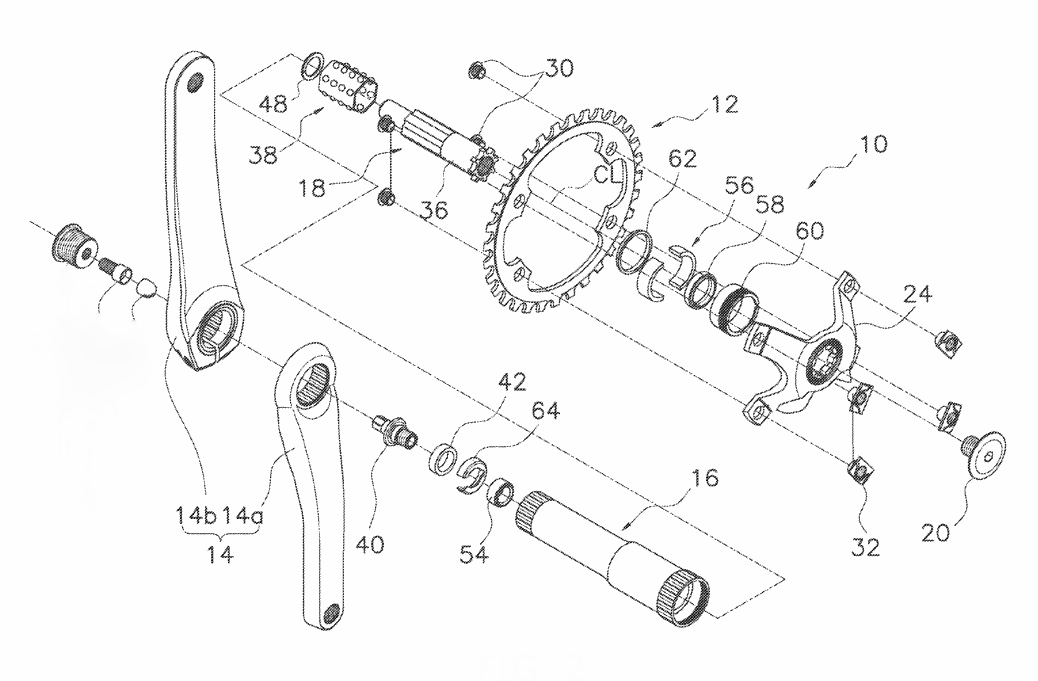

The British website, Cycling Industry News, recently discovered patents from Shimano and SRAM, which suggest the two leading component manufactures have been fast at work honing the virtues of 1X groupsets – with the goal of creating drivetrains that are both quieter and more efficient.
Perhaps, the greatest challenge of any 1X groupset, is taking into account the extreme angles the chainline in place at while trying to accommodate what can be an extreme range of gear ratios.
In the case of Shimano’s patent, the Japanese component giant shows a chainset that appears to sit on some sort of a sliding mechanism which allows the chainring to move independently from the crankarm, as a means of preventing it from dropping the chain at extreme angles.
The description on the patent, which is now registered in Japan and the U.S., reads:
“Among bicycles equipped with a single front sprocket and a plurality of rear sprockets, gear shifting has been conventionally carried out by operation of a rear derailleur. When a gear shifting operation is performed by operation of the rear derailleur, chances are that a chain is disposed in an oblique position relative to the faces of the front sprocket while being wound around the front sprocket and any of the rear sprockets. When the chain is disposed in an oblique position while being wound around the front sprocket and any of the rear sprockets, it is concerned that the chain may be disengaged from the front sprocket. In light of this concern, a conventional construction has been proposed for making the chain unlikely to be disengaged from the front sprocket. In this conventional construction, the front sprocket is configured to be movable in an axial direction arranged in parallel to a rotational center axis whereby the chain is unlikely to be disposed in an extremely oblique position.”
“A bicycle crank assembly includes a sprocket having a rotational center axis, a crank, a crank axle and a slide mechanism. The crank axle is attached to the crank and includes an internal space. The slide mechanism is configured to displace the sprocket relatively to the crank in an axial direction parallel to the rotational center axis. At least part of the slide mechanism is disposed in the internal space of the crank axle.”
Conversely, SRAM’s design depicts the chainring itself being able to adapt to an altering chainline, whereby the chainring is essentially divided into two, which allows it move slightly in order to accommodate changes in the chainline.
According to the images, the chainring itself appears to be mounted on a special carrier or spider, that will also allow it to adapt to changes in angles.
The description reads:
“Attempts are often made to avoid problematic shifting under load at the front chainring. Instead of this shifting under load coverage of as much as possible of the gear spectrum is achieved by means of a correspondingly developed rear multiple sprocket arrangement. A front single chainring together with a high number of eleven or twelve rear sprockets can achieves good coverage. On account of the high number of axially adjacent sprockets on the rear wheel, the width of the multiple sprocket arrangement is certainly enlarged. The chain that meshes with the chainring is also axially secured on the front chainring by means of the axially secured single chainring. On the rear wheel, however, the chain has to overcome a section of several centimeters when shifting from the smallest to the largest sprocket in the axial direction. This increasingly results in the chain running at an angle (also called skew) which has a negative effect on the efficiency, the wear susceptibility, and the noise development of the drive.
“Possible solutions which deal with this problem are known from the prior art. Axially displaceable single chainrings which are to adapt to the chain line are thus provided.”
“A chainring includes a first chainring segment and a second chainring segment for a chainring arrangement of a bicycle. Further provided is a chainring arrangement and a drive arrangement for a bicycle with at least one chainring. The segmented chainring arrangement is particularly suitable for bicycles with only one front chainring.”
More detailed documentation about Shimano and SRAM’s proposed 1X groupset patents can be read at USPTO Application # 20170167542 and USPTO Application # 20170167590.






